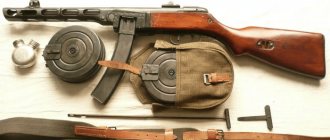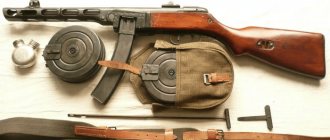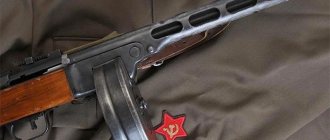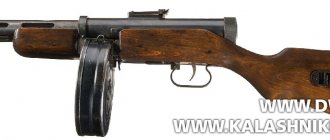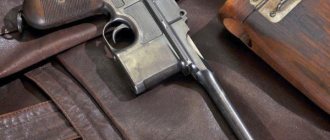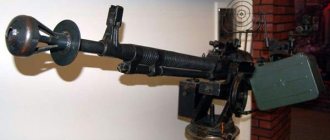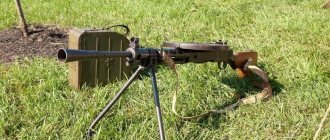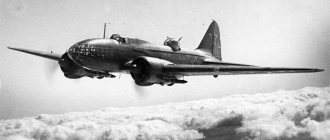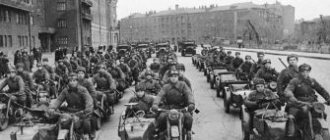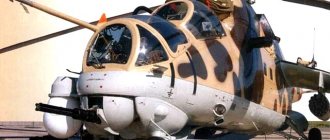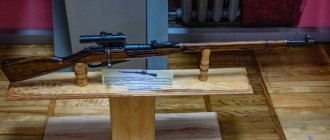One of the traditions of the domestic weapons school is associated with such requirements for weapons as reliability, cost-effectiveness in manufacturing, and ease of operation. One of the prominent representatives of this school is Hero of Socialist Labor Georgy Semenovich Shpagin, designer of the famous PPSh-41 submachine gun. The famous “Pepesh” 80 years ago, on December 21, 1940, was adopted by the Red Army. It is Shpagin who is credited with the aphorism: “To make something difficult is easy, but to make it simple is very difficult.” Victory Museum historian Alexander Mikhailov spoke about the history of the creation of the PPSh-41.
Submachine guns
The first submachine guns appeared at the end of the First World War. The troops needed a compact machine gun to support infantry during the assault on enemy fortifications and in battles in urban areas.
In Germany, such a weapon was the Bergman MP-18 automatic carbine designed by Hugo Schmeisser, in Italy - the Beretta M1918. They managed to take part in hostilities in Europe.
The real boom in submachine guns occurred during the interwar period. Designers from different countries sometimes saw the development of submachine guns differently. The main requirements for weapons were the following: the use of pistol cartridges and a rate of fire comparable to machine guns. Hybrid weapons were created precisely to replace machine guns, which were expensive and difficult to operate. It was precisely this path that was followed, for example, by the Finnish military, which adopted the Suomi submachine gun, designed in 1931 by the self-taught engineer Aimo Lahti.
In Russia, back during the First World War, the first automatic weapon was adopted - the Fedorov assault rifle of the 1916 model, created for a rifle cartridge. Of course, the machine gun has nothing to do with submachine guns, but domestic designers had experience in creating automatic weapons.
After the end of the Civil War and the restoration of industry, including the defense industry, the USSR in the second half of the 1920s began developing small arms, including submachine guns. The first such weapon was a submachine gun developed in 1927 by designer Fedor Tokarev for the pistol cartridge of the Nagan system revolver.
© gaspiko.ru Georgy Shpagin.
The weapon was experimental and was not accepted for service, but the 600 samples produced were sent to the border troops. A certain number of these submachine guns remained in the army at the beginning of the Great Patriotic War. The Tokarev submachine gun was very expensive to produce, and the pistol cartridge for it was obsolete and did not meet the requirements of the military.
Options and modifications
During its long existence, the PPSh was modified more than once, and a huge number of types of this machine gun spread throughout the world.
It is impossible to list all of them due to the wide distribution and uncontrolled movement of this software.
Officially, it was supplied to countries such as China, Vietnam, Poland and Cuba.
Factory Soviet models:
- PPSh-41 arr. 1941 – first sample. It was equipped only with a drum magazine and a sight designed for shooting at a distance of up to 500 m.
- PPSh-41 arr. 1942 – differs from the ’41 model by a chrome-plated bore (Increases wear resistance), more reliable fastening of the clip and the elimination of an involuntary shot when falling. It was equipped with an aiming device for shooting at 100 - 200 meters. A sector magazine made of steel 0.5 mm thick (Later – 1 mm);
- PPSh-2. In 1943, a competition was announced for the development of a new submachine gun, which was supposed to be a replacement for the PPSh. The main requirements were maintaining combat qualities, reducing weight and dimensions. The product presented by Shpagin, although it was further simplified in production, did not meet the requirements. The choice fell on the project of the gunsmith Sudakov.
Handicraft and semi-handicraft models:
- “Product No. 86” - were manufactured in Kandalaksha on the territory of plant number 310. Before receiving the drawings, 100 products were produced. All of them were made by hand and their parts were not interchangeable. Like production models, the machine gun was equipped with a drum magazine;
- Many samples of the Shpagin submachine gun were made in the workshops of various partisan detachments operating on the territory of Belarus;
- Jelen - Croatian semi-handicraft modification, which was actively used in the wars on the Balkan Peninsula.
In the ranks of the Third Reich:
- MP.41(r) – captured PPSh-41 converted to the 9x19 “Parabellum” pistol cartridge, common among the Germans. The weapon had a replacement barrel and a receiver for clips from the MP-38/40. In total, about 10,000 pieces were converted.
During the Second World War and after its end, PPSh was produced in many countries. Among them were China, Yugoslavia, Iran, Croatia, Vietnam, Hungary, North Korea, etc.
Basically it was an ordinary Shpagin submachine gun. Only in rare cases were minor modifications made to suit the realities of local industrial potential.
Conversion options
- PPS-50 – Manufactured by Pletta. Uses small caliber ammunition - .22 LR;
- SR-41 Semi-Auto Rifle – Produced by the American arms company “Inter-Ordnance of America”. There is a modification chambered for 7.62x25 and 9x19 mm. Has an increased barrel length. American weapons connoisseurs have always spoken highly of the PPSh-41.
- SKL-41 – developed for the 9x19 cartridge. Start of production 2003
- PPSH 41 SemiAuto is a self-loading modification using a 7.62x25 cartridge. The key feature is an extended barrel (up to 16 inches), a casing without specific and recognizable oval holes. Shooting occurs with the shutter closed. Manufactured by the American company “Allied Armament”;
- VPO-135 – Cartridge 7.62x25. System: self-loading carbine. Date of development: 2013. Produced by the Molot plant;
- PPSh-O - Cartridge 7.62x25. System: self-loading carbine. Date of development: 2013. Produced by the Kovrov plant named after Degtyarev;
- MR-562K "PPSh" - a pneumatic version developed at the Izhevsk plant. Shoots 4.5 mm metal balls. Can fire in bursts.
First there was... a cartridge
Until 1930, two versions of cartridges were produced in the Soviet Union: rifle, 7.62x54 mm, for the Mosin system repeating rifle and the Maxim system machine gun, and pistol, 7.62x38 mm, for the Nagan revolver. A new powerful cartridge was needed for the submachine gun. A 7.62x25 mm cartridge was developed. The prototype was a German cartridge of 7.63x25 mm caliber. It was precisely under the new pistol cartridge that Soviet gunsmiths began to create a new self-loading pistol and submachine gun in the same year. In 1930, the TT pistol of Fedor Tokarev was adopted by the Red Army. Later it was technologically improved.
Active work on the creation of a submachine gun began in 1929. A new competition for the creation of this weapon was announced in 1930, with the adoption of a new cartridge. Sergei Korovin, Sergei Prilutsky, Vasily Degtyarev, who created his own version based on the DP-27 infantry machine gun, submitted their works to the competition. The project was presented separately by the team of the Kovrov Arms Plant named after K.O. Kirkizh.
But only the second competition, held in 1931, revealed the winner. It was the project of Vasily Degtyarev. The PPD-34 sample became the first serial Soviet submachine gun adopted by the Red Army on June 9, 1935. During operation, changes were made to the design of the PPD-34. So, the army first received PPD-34/38 and later PPD-40. They were used during the Soviet-Finnish and Great Patriotic Wars.
Why not PPD
The Soviet command never took the PP seriously. It was considered a weapon for the police and gendarmes. However, some Soviet designers proactively developed projects for their submachine guns.
One of these people was Degtyarev. Its PPD-34 was mass-produced and mainly served in the ranks of the NKVD border service.
After the Winter War with the Finns, who massively used Suomi PP. The leadership of the Red Army urgently instructed Degtyarev to finalize the PPD-34.
And in the winter of 1940, he presented a new modification of his project - PPD-40.
By the beginning of the Second World War, about 90 thousand copies of it were produced.
At the same time, Stalin ordered the involvement of the best gunsmiths in the creation of a new PP, which would be easier to produce, but retain the combat qualities of the PPD-40. The Degtyarev submachine gun itself is complex. To create it, you need high-precision equipment and manual grinding.
From PPD to PPSh
The production of PPD-40, the forerunner of the PPSh, was a temporary solution to replace the PPD-34/38. Their production required high-precision measuring and production instruments, precision milling machines and technical specialists. The PPD-40 design had 95 parts. It took more than 15 man-hours to produce one copy.
Georgy Shpagin participated in the 1940 competition to develop a new submachine gun to replace the PPD-40. His sample turned out to be very technologically advanced in production and showed excellent ballistic characteristics. For the production of PPSh-41, cold stamping and spot welding were used for the first time in the weapons world; the weapon consisted of 87 parts and two threaded connections. The cost was 500 rubles per piece, and production required just over 7 man-hours.
© From the Victory Museum fund
PPSh-41 at the top of the first series mod. 1941, below the second modified series of 1942.
Already during the war, Shpagin improved weapons, where the number of parts decreased, but the characteristics and reliability remained at a high level. Manufacturing time was reduced to 5 and a half man-hours, and the cost in 1945 was 132 rubles.
Reasons and process of creation
Drawing conclusions from the Soviet-Finnish War (1939 - 1940), the leadership of the USSR gave the order to develop a modern and technologically advanced submachine gun (PP). The new weapon was supposed to match the combat characteristics of the PPD-34/40 (Degtyarev PP), but be easier to manufacture.
By the fall of 1940, G. Shpagin and B. Shpitalny presented their projects to the commission of the People's Commissariat of Armaments.
At the end of November, the Shpagin design bureau produced 25 products, the Shpitalny design bureau produced 15 units intended for testing tactical and technical characteristics. Along with the presented samples, PPD-40 also took part in the tests.
The tests included testing for structural strength, accuracy of fire, combat rate of fire and weight-dimensional characteristics.
By the end of the tests, the commission concluded that the Shpagin submachine gun was more suitable for the needs of the Soviet armed forces. Since it has better reliability, its parts are less susceptible to wear, with a mass equal to the PPD, it is easier to manufacture, and is not much inferior to the Shpitalny PP in accuracy and magazine capacity (but it weighs 1.5 kg more).
As a result, in December 1940, a decree was signed on the adoption of Shpagin's software and the start of its production. The project presented by Shpitalny was sent for revision, citing the low reliability of the automation.
What's inside?
The operating principle of the PPSh-41 submachine gun is based on the use of blowback recoil. In addition to automatic firing, it is possible to conduct single fire. The fire mode translator is located inside the bracket in front of the trigger. The design of the fuse is identical to that of the PPD-40 and is made according to the principle of a slider located on the bolt cocking handle. It can block its operation in the forward or rear position.
Like the Degtyarev submachine gun, the Shpagin's receiver and barrel casing are one part, which is attached to a wooden stock made of birch. Sighting devices were located on the receiver in the form of a sector sight with a gradation of firing from 50 to 500 meters.
Only the barrel required fine and precise machining in the manufacture of the PPSh-41. The bolt was made on a lathe with rough milling. Most other metal parts were made by stamping.
One of the design features of the Shpagin submachine gun barrel casing is an integrated muzzle brake-compensator, which protruded beyond the muzzle of the barrel and was an angled plate with through windows. When conducting automatic fire, the muzzle brake-compensator, due to the action of powder gases during a shot, significantly dampened the recoil, which increased the accuracy and accuracy of fire. For ammunition supply, the PPSh-41 was equipped with a drum-type disk magazine with 71 rounds.
Advantages and disadvantages
Pros:
Simplicity of design and high technology of production
Maximum rate of fire of 1000 rounds per minute
Uses a powerful 7.62 mm PPSh cartridge, with a bullet that is capable of penetrating obstacles in its flight path
Possibility to produce at non-core enterprises
Minuses
Weight 5.3 kg with loaded magazine. For comparison, the weight of the AK-74M is about 3.6 kg
Large weapon size, which is very inconvenient in confined spaces
Each machine came with only 2 disc magazines.
Problem with the unification of the magazine receiver shaft
Without setting the safety, there is a high probability of a crossbow
Poor ergonomics
Production
Mass production of the PPSh-41 began only in May 1941, literally a month before the start of the Great Patriotic War. It was decided to establish production at a new, essentially under construction, Zagorsk hardware factory, which received this name for secrecy purposes. Shpagin was transferred to work there.
By the beginning of the war, there were few PPSh-41s in the army. The plant began operating at full capacity in July 1941, producing thousands of weapons per day. As the front approached, production was evacuated to the workers' village of Vyatskie Polyany.
The simple production technology of PPSh-41 made it possible to launch its production in unprepared production areas, by not the most qualified specialists. In 1941, enterprises in Zagorsk, Moscow, Izhevsk, Alma-Ata, Tomsk, Vladivostok and other cities produced 90 thousand units. And already in 1942, 2.5 million of them were sent to the front.
© From the Victory Museum fund
Fragment of the exhibition Feat of the People - arms factory producing PPSh-1.
Myths and legends about PPSh
Several interesting myths that have formed around Shpagin’s product:
- Some believe that Shpagin completely copied his machine gun from the Finnish Suomi. The situation is far from the truth, since, apart from the external similarity, the weapons are nothing alike. Moreover, the designer took PPD as a model;
- The Red Army lacks automatic weapons. This is a common myth, but has no basis in reality. The number of machine guns in the Red Army exceeded that of the Wehrmacht;
- PPSh-41 is considered the best PP during World War II. Dissemination in the cultural environment itself launched this legend. It’s just that in the USSR PPSh was shown more often than PPS-43;
- Fact. According to official data, the last country that managed to keep the PPSh-41 in the army was Belarus.
"Papa"
At the front, many types of weapons and military equipment were given affectionate nicknames by soldiers that were consistent with their markings. Thus, the 76-mm ZiS-3 divisional gun was nicknamed “Zoseya”, the 152-mm ML-20 howitzer gun was called “Emelei”, and the Tokarev self-loading rifle “SVT-38/40” was called “Svetka”. The soldiers nicknamed the PPSh-41 submachine gun “Daddy.”
Shpagin's weapon at the front was simply irreplaceable for scattering chains of advancing infantry, when storming enemy fortifications and trenches, and in battles in the city. Until some time, the PPSh-41 was the standard weapon of tank crews and armored car crews.
Work on mistakes
During military operation, changes were made to the design. The disk magazine, originally borrowed structurally from the Finnish Suomi-M31, turned out to be not the most reliable structural element.
The magazine was first converted for the PPD-40, after which it was inherited by the PPSh-41. Its production remained difficult, but justified, based on the capacity of 71 rounds.
© From the Victory Museum fund
A Red Army soldier with a PPSh-41 in battles near Moscow.
For each sample, two or three disk magazines were made. It happened that the magazine from one PPSh did not fit another. In this regard, on February 17, 1942, a new box magazine with 35 rounds was accepted for production. Manufacturing technology has been improved and quality control has been strengthened. But in wartime conditions this was difficult to do. Until the end of the war, both types of magazines were used in the army.
The design of the sight has changed. A reversible rear sight appeared with a gradation of “10” and “20”, which meant 100 and 200 meters, and not “from 50 to 500”, as was previously the case on the sector sight.
Another disadvantage of the PPSh-41 was its weight. The loaded submachine gun weighed almost 5 kg. The designer wanted to change this parameter when creating PPSh-42 or PPSh-2. However, at the competition at the end of 1942, where Shpagin presented his sample, Alexei Sudayev’s PPS-43 won in the final. The more compact and lighter PPS-43 was received by military personnel of armored, reconnaissance and sabotage, and airborne units.
Several variants and modifications of the PPSh-41 have been developed. For example, “PPSh-Bramit”, designed for silent shooting. It was assumed that specialized units would be armed with such silent weapons for operations behind enemy lines.
© mycity-military.com
Experimental version of PPSh-Bramit.
Another experimental model created by Kovrov gunsmiths in 1945 on the basis of Shpagin’s weapons was a curved-barreled submachine gun. The barrel bore and weapon casing were bent by 30 degrees. This option was developed for armored vehicle crews, as a weapon of last chance, if there is a high risk of the combat vehicle and crew being captured, as well as for shooting from a trench. However, this version was also rejected by the military.
We also considered the use of PPSh-41 in aviation. In mid-1944, the firepower of the PPSh was expected to be used to storm enemy infantry columns on the march or during battle. For this purpose, a special platform structure was designed, which was located in the bomb bay of the Tu-2Sh bomber. 88 PPSh-41 submachine guns were mounted on it. This entire structure was named “PPSh Battery”. It was assumed that during the attack the pilot opened the bomb bay and, using a special sight, opened fire on the enemy.
© From the Victory Museum fund
PPSh-41 in the bomb bay of a Tu-2Sh bomber.
Only by the beginning of February 1946 did the PPSh Battery undergo flight tests. Despite the fact that it showed great efficiency, firing due to the high rate of fire of the weapon was short-lived, and it was impossible to change the ammunition supply of the PPSh except from standard disc magazines with 71 rounds. As a result, it was decided to use small-caliber cluster bombs to destroy enemy personnel.
© From the Victory Museum fund
Decorated with stickers, the PPSh is a trophy of the Soviet Army from Afghanistan in the 1980s and the experimental curved-barreled PPSh-41.
Unknown PPSh rivals
The path of the submachine gun in the Red Army's weapons system was long and winding. Interest in this type of weapon was shown by the Armament Commission back in the mid-20s. A few years later, the first submachine guns appeared in the USSR - Thompsons purchased in the USA, which were successfully used by border guards in battles with the Basmachi.
Domestic SMGs began to appear in any noticeable quantities in the army only in the late 30s. Not least of all, this was due to the fact that the Degtyarev model 34 submachine gun adopted for service, with relatively acceptable performance characteristics, was characterized by low manufacturability, which made mass production very problematic. Attempts by the spacecraft management to resolve this issue led, on the one hand, to the appearance of the PPD-40, which was simplified in design, and, on the other, to the adoption of an even more technologically advanced model of Shpagin’s design - the legendary PPSh.
In addition, before the war, the prospects for PP as a mass weapon were indeed not entirely clear. Although in the relevant articles it was customary to throw incriminating lightning at Marshal Kulik, who allegedly considered the PP a “purely police weapon,” the reality was somewhat more complicated - in the USSR the development of self-loading and automatic rifles was in full swing, which in terms of performance characteristics was clearly superior to the “ratchet” chambered for a pistol cartridge , which in production cost almost as much as a full-fledged “handbrake”. The successful use of the Suomi PP by the Finns, although it prompted the command of the Red Army to return the PPD to the units, nevertheless, the need for such weapons is not only for certain categories of military personnel - drivers, gun crews, tank crews, etc. - but also for ordinary infantrymen still seemed doubtful.
Above – the first sample of the Artakademiya PP (designer Bezruchko-Vysotsky) Below – the modernized Degtyarev PP
But... there would be no happiness, but misfortune helped. The reality of the first year of the great war turned out to be darker than any pre-war forecasts. To make up for losses, the newly formed divisions of the army needed weapons - many, many and even more. Preferably automatic, especially since the legends about “companies of German machine gunners” and that every second Fritz, not counting every first, was armed with a submachine gun, came from the front almost from the first days of the war.
However, even the hastily launched production of PPSh at “non-core” factories was not enough. In addition, its design was not devoid of the so-called. “bottlenecks” - in the fall of 1941, in particular, the shock absorber turned out to be a problematic part[1]. In addition, for many - for example, in Samarkand, where the Artillery Academy was evacuated from Moscow, there was a shortage of common wood for butts.
The war strictly dictated new requirements - and at the beginning of 1942 (from February 25 to March 5), the first samples of submachine guns, created taking into account the experience of the ongoing war, were tested at the NIPSVO training ground.
The following were submitted for testing:
- Shpagina lightweight.
- Degtyarev modernized No. 2 and 3.
- Art Academy of the 1st sample of Bezruchko-Vysotsky’s design.
- Artacademy 2nd sample design by Menshchikov and Shkvornikov
- Zaitsev (OKB-16) 1st sample
- Zaitsev (OKB-16) 2nd model
- Northwestern Front No. 32/14
- Gross submachine gun PPSh-41
- German MP-40 submachine gun.
Another 2 samples - PPKF, developed in the Karelo-Finnish SSR and the design of the ship repair workshops of the military port in Stalingrad did not reach the test site, having “failed” in preliminary tests. The “Stalingrader” especially distinguished himself, for two days in a row he “ gave complete misfires.”
».
Separately, I would like to say a few words about number 9 on the list - the German MP-40. With the beginning of the Second World War, domestic designers finally had the opportunity to become familiar with the main representative of this class of weapons in the German army. And although in Soviet historiography it was customary to assert that this PP was head and shoulders below domestic designs, documents from those years allow us to conclude that an impression was still made, and what an impression at that. In particular, the test report states the following:
Almost all samples take into account the design features of the German
MP-40 model, for example:
a) all prototypes have a trigger mechanism without single firing, a rigid firing pin, a sight with folding shields;b) in addition: PP Degtyarev, Artakademiya 1 and 2 samples and Zaitsev 2nd sample have folding stocks, two Artakademiya samples have shaped safety cutouts for the bolt handle, etc.[2]
"And so on." especially applied to the 2nd model of the Art Academy, which: “ basically represents the design of the German
MP-40 submachine gun with a simplification of the design of individual components in order to simplify them technologically and reduce the weight of the system” [
3] and to the Zaitsev PP
,
in which the difference between 1 1st and 2nd samples manifested itself in the fact that: “
in the 2nd sample the influence of the German MP-40 sample is noticeable
.”
This, of course, was not the first time that Soviet small arms designers “looked closely” at the work of their foreign colleagues - just remember the history of the appearance of a drum magazine in the PPD instead of a box magazine with 25 rounds. In 1942, however, box magazines “came into fashion” again - they were hastily developed for the PPD and PPSh already in production, and even more so, promising samples had to “match.” But reading the lines of the report, it is difficult to get rid of the impression that the designers were shown the MP-40 as a technical specification with the words: “ Make us the same, but simpler.”
! – perhaps even with an explanation that for those who do not fully understand the “severity of the moment”, there will always be vouchers to occupational therapy institutions in the Far East and Far North.
Artakademiya submachine gun
One of the initial stages of testing was to determine accuracy: shooting at shields at a distance of 100 and 200 meters with single fire and at a distance of 50 and 100 meters with automatic fire.
| Name of samples | Single fire | Automatic fire (bursts of 4–5 shots) | ||||||
| 100 m | 200 m | 50 m | 100 m | |||||
| Ch50 | R100[4] | Ch50 | R100 | Ch50 | R100 | Ch50 | R100 | |
| Shpagina lightweight | 9,2 | 22,5 | 23,8 | 51,7 | 10,5 | 37,7 | 21,2 | 46,5 |
| Degtyareva | 12,8 | 30,2 | 26,8 | 50,7 | 12,2 | 36,0 | 20,7 | 60,7 |
| ArtAk 1 arr. | 15, 2 | 39,5 | 39,7 | 73,3 | 12,3 | 37,5 | 24,7 | 56,2 |
| ArtAk 2 arr. | 12,0 | 35,2 | 28,3 | 68,3 | 7,8 | 23,0 | 14,3 | 46,7 |
| Zaitseva 1 arr. | 12,0 | 37,8 | 28,3 | 76,7 | 8,3 | 24,3 | 19,8 | 56,7 |
| Zaitseva 2 arr. | 11,7 | 31,2 | 22,0 | 69,3 | 6,7 | 24,8 | 12,0 | 32,5 |
| Northern Western Front | 14,7 | 33,0 | 24,2 | 74,7 | 9,5 | 25,2 | 14,0 | 42,7 |
| PPSh-41 | 10,5 | 26,3 | 20,5 | 55,8 | 7,3 | 18,0 | 15,7 | 48,8 |
| MP-40 | 10,5 | 18,0 | 20,0 | 45,0 | 7,0 | 18,5 | 19,3 | 47,0 |
The result of this stage of testing was the quite logical conclusion that the total weight of the system has the greatest influence on accuracy. They also noted the influence of the dynamic shoulder - Degtyarev’s PP, which had the most significance for this characteristic, did not show off its accuracy. The love of domestic designers for compensators has not gone unnoticed.
The presence of a compensator in itself does not solve the issue of improving the accuracy of combat when other factors are unfavorable, and an overly strong compensator can even worsen the accuracy of combat, for example: in the 1st sample of the Art Academy, when firing, the muzzle of the barrel is thrown down, and accuracy is obtained the worst.[5]
For some reason, the testers did not consider it necessary to note the high accuracy of the German MR, but they “praised” it indirectly - in the form of a positive assessment of its Soviet copy, the 2nd sample of the Art Academy: “ The shocks in the rear position of the bolt are weaker than those of other samples, as a result of which it shakes less and shooting is more convenient
" By the way, the rate of fire of the “German” and its Soviet twin was 2–3 times lower than that of the others.
Incomplete disassembly of the Artakademiya PP
I immediately remember that in many Soviet reference books, when talking about the MP-40, it was usually considered good manners to insert the phrases: “When firing at a distance of more than 200 meters, the effectiveness of fire dropped sharply,” “with PPSh you can hit targets 500 meters away from MP-40 it was impossible.” The size of such a goal was modestly kept silent.
The next point of testing was the determination of operational characteristics - ease of assembly, disassembly, loading, aiming and shooting. Almost all samples received comments here. For example, Degtyarev’s PP was given for the same short butt, “ as a result of which, during aimed shooting, blows from the butt plate on the shooter’s nose are possible.”
.»
But the most important test was yet to come. Having the sad experience of the Tokarev self-loading rifle, which after the start of the war received a whole wave of complaints from the army about unreliability [6], the testers took a particularly careful approach to the issue of testing samples for reliability and survivability. The shooting was carried out under the following conditions:
- with thick lubrication;
- when dusted with cement dust for 10 minutes in a special box;
- with parts washed with kerosene and wiped dry;
- at elevation and declination angles of about 90 degrees;
- after a 12-hour stay in the snow (in cold weather about 10 degrees).
A total of 2,329 shots were fired from the new Shpagin PP and a 3.3% delay rate was obtained. The largest number of delays was obtained after dusting - 15%, after the PP was on snow - 8% and at declination angles - 5.7%.
After 1008 (or 2808, taking into account previous firings from the sample), cracks appeared on the rear wall of the receiver cover and the fiber shock absorber cracked. After 2329 shots (or 4129 in total), barrel wobble was detected.
The commission considered it inappropriate to continue testing the Shpagin PP under these conditions.
Three percent doesn’t seem like much... if you don’t think about what’s behind these dry numbers in the report. Three rounds out of a hundred... a chance to “catch” a delay in almost every disc or horn. And in a battle, even one – the last one – will be more than enough.
PP Degtyareva modernized
2374 shots were fired from the Degtyarev SMG and 0.5% delays were obtained.
The largest number of delays was obtained after the PP was on snow -4%. At elevation angles close to 90 and with thick lubrication, the submachine gun refused to fire, giving continuous failure of cartridges to advance. Also, during the tests, the sear axis became loose, which was riveted several times, and the folding stock also became loose. As a result, the PDM went after Shpagin’s brother - for revision.
From the 1st sample of the Artakademiya, 2233 shots were fired before testing was stopped and 0.6% delays were obtained. After this, the PP was found to have: “ cracks at the rear walls of the receiver, trigger box, near the barrel pin and near the figured safety cutout
“- behind this dry line there is almost certainly hidden a much more emotional “it’s about to go to hell!”
The 2nd sample of the Artakademiya lasted eight shots less - 2225 shots were fired from it, while receiving 1.1% delays. The largest number of delays was obtained at elevation angles, with thick lubrication and after dusting - 2% each. After 920 shots, the front sight flew off, and after 2022, the fiber buffer burst. This is where the tests ended and for the Menshchikov-Shkvornikov design - there was no spare buffer suitable for their sample at the test site.
1,667 rounds were fired from the 1st sample of the Zaitsev PP - having received 10.3% delays, the submachine gun was removed from testing. The 2nd PP performed slightly better - 2247 shots and 3.2% delays - but this “slightly” was clearly not enough to continue testing.
The PP of the North-Western Front became an outsider - 387 shots and 15.2" delays, plus the fly-off base of the front sight with the front sight.
It is possible - and quite easy - to imagine what epithets the soldiers at the front would award to the designers if they had to go into battle with such “reliable” models. The commission that carried out the tests understood this very well - and its final conclusions turned out to be very unhappy for most designers.
In terms of ease of handling and shooting from different positions, not a single model fully satisfies modern requirements, but the 1st model of Artakademiya and Degtyarev is better than others in this regard.
In terms of trouble-free operation of the automation, only the 1st sample of the Art Academy (Bezruchko-Vysotsky) passed the tests.
In terms of survivability, not a single sample passed the test
.[7]
As a result, it was recommended that the two above-mentioned samples be modified taking into account the recommendations made by the commission and submitted for repeated testing no later than April 5, 1942. The commission considered it inappropriate to modify the remaining structures.
True, not everyone was able to listen to the “good advice”. The designer of OKB-16 Zaitsev, in an “initiative” manner, finalized his software and submitted it to the 2nd stage of testing. Having suffered a second failure in a row, he tried to “replay” the test results according to different rules, writing a letter full of indignation personally to I.V. Stalin.
However, the story with the Zaitsev PP did not at all become the main intrigue of the next stage of testing, which began on April 26, 1942. In addition to the already familiar systems of Degtyarev, Bezruchko-Vysotsky and the above-mentioned Zaitsev, this time samples from Tula Korovin (plant No. 535) and Ogorodov reached the test site (NKVD troops). And most importantly, this time NIPSVO itself, better known for the development of anti-tank rifles by Rukavishnikov and... Sudaev, “rolled out” its developments.
- Described in the book by Bolotin D.N. – “Soviet small arms”
- TsAMO RF, fund 81, inventory 12040, file 4.
- Right there.
- R100 is the radius of the circle within which 100% of the series hits fit. R50 is the radius of the circle within which 50% of the best hits in the series fit.
- TsAMO RF, fund 81, inventory 12040, file 4.
- It is worth noting that perhaps its main reason was the inability of the then ordinary conscripts to provide the weapons with the care required by the instructions. For more trained personnel (for example, the Marine Corps), the operation of SVT did not cause such problems.
- TsAMO RF, fund 81, inventory 12040, file 4.
"Symbol of Victory"
During the Great Patriotic War, almost 6 million Shpagin submachine guns were produced. This is the most popular weapon of this class not only in the USSR, but also among other countries participating in the war. PPSh-41 went through the entire war and took part in all the key battles. Mikhail Egorov and Meliton Kantaria with PPSh-41 at the ready in May 1945 hoisted the Victory Banner over the Reichstag in Berlin.
The weapon created by Georgy Shpagin, along with the T-34 and IS-2 tanks, La-7 and Il-2 aircraft, became a real symbol of Victory.
PPShs were in service with the Soviet Army until the mid-1960s, until they were replaced by Mikhail Kalashnikov’s assault rifle. Shpagin's brainchild was manufactured in dozens of countries in Europe, Asia and Africa and is still in service in some places.
© From the Victory Museum fund
Fragment of the exhibition Feat of the People - arms factory producing PPSh-1_From the collection of the Victory Museum.
Cultural significance
The Shpagin submachine gun is extremely common in the cultural environment of Russia and the entire post-Soviet space. It's in games, movies, books and songs. No wonder. After all, on monuments in honor of WWII heroes, soldiers are often depicted with PPSh in their hands. The machine gun is gaining popularity in the Western world. Pseudo-historical films and computer games are especially different.
Collectors strive to get the most authentic PPSh into their collections. Products produced between 1941 and 1945 are especially valued. Since they may have a military history behind them.
Artifacts of the Victory Museum
The exhibition and collections of the Victory Museum feature 17 PPSh-41 submachine guns manufactured in 1941–1945, including a rare experimental curved-barreled PPSh. In the “Feat of the People” section there is an exhibition stylized as a factory workshop, dedicated to the production of small arms during the war by women and children, who replaced the men who went to the front at the machines. Visitors to the Victory Museum can try to assemble a front-line weapon - the famous PPSh-41 submachine gun - manually or using modern multimedia touchscreen screens.
Operation and combat use
PPSh were mainly used by linear Soviet infantry units to destroy enemy personnel. The submachine gun performed especially well in urban battles, where its rate of fire did not allow the enemy to emerge from behind cover. The machine gun was perfect for clearing rooms and trenches. Thus, it was used until the very end of World War II.
The PP performed well in the hands of the partisans. The weapon made it possible to inflict maximum damage in a short time. Typically, the PPSh fell into the hands of the partisans when Red Army soldiers joined, captured from the Germans, assembled in field workshops, or as cargo from the “mainland.”
An interesting fact: the partisans did not really like the PPSh. Its parts required a large number of stamped and welded parts. But low-tech PPD, on the contrary, was valued - after all, it could be completely turned on a machine. The partisans were even given drawings of machine guns. The only problem was the barrel, but it was made from damaged rifle ones.
One of the last full-scale conflicts in which PPSh was used was the Vietnam War. PP was used there in limited quantities. The weapons were supplied from China, but the Vietnamese sawed off part of the casing and welded on sights from French machine guns. The wooden butt was removed and a metal, folding one was installed instead. The modification went down in history as the K-50M.
